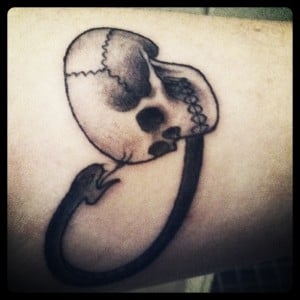The Met Does Punk Fashion
When I read this year’s Met Costume Institute’s Exhibition title, I pictured a gaggle of celebrities and Vogue editors in Swarovksi studded safety pins and clip in pink hair extensions made of mink and just about died. Punk is, of course, completely antithetical towards everything Vogue and the Metropolitan Museum of Art represent. Punk is accessible, punk is messy, and as soon as you figure out what punk is, punk is changing. Last night’s Met Gala, the exhibit’s formal opening, is an event catering to celebrity and commercial success, a party thrown by very rich people for very rich people. And the idea is to bring the world’s most powerful and influential shiny people together. This years exhibition title: “Punk: Chaos to Couture.”
The Metropolitan Museum of Art and the suits that run it are certainly not the first to conflate Punk with Fashion. (That would be Vivienne Westwood) The irony doesn’t lie in having punk – the music, the culture, the anti-politics – boiled down to an aesthetic. The irony is that The Met basically IS the Man. Last year, they pared down Andy Warhol’s oeuvre and influence to a bland timeline of aesthetic similarities, so the teenager in me can only feel mother-bear protective of letting a bunch of rich, old people curate angst.


EDIT: Polyvore, live tweeting the red carpet, just posted: “Vivienne Westwood IS #punk. No one should ever cut her off, especially not at the #MetGala when she’s trying to talk :(”
When I saw that they had cut off Vivienna Westwood I had to take a pause.
I’m not a teenager anymore, so I have to examine the reasons why my misgivings give me misgivings. One, as pointed out sublimely in Kate Carraway’s “Obseshes” for VICE, is that I was never punk. Operation Ivy, Minor Threat and Black Flag taught me how become a human being at a formative age, and I had a ton of feelings with no place to go, but I stayed in school and became dance team captain and loved my parents, all without breaking bones. So why does the adoption of a movement, created nearly 2 decades before I was conceived, perfected a single decade before I was born, and revived while I was in kindergarten, by the rich and famous feel so sacrilegious?
Nitsuh Abebe of New York Magazine explains. In “This Is Punk?” from April 29, he calls punk a “superword” (a term coined by Frank Kogan.) A superword’s primary function is to spark debate over the word’s meaning. So a superword is basically the most punk rock of all the words. In furiously texting my most punk rock friend over the course of the past 2 weeks (after explaining what the Met Costume Institute is and why The Met Gala is a huge deal. He’s so punk he don’t even know!) I realized we are guilty of bastardizing the stuff just as much as those who commodify it as an aesthetic ideal. Punk is anti-upper echelon, so what good is it to boil it down to a single philosophy? It is no more in keeping with punk’s punkness than Sarah Jessica Parker’s mohawk-style headpiece by Philip Treacy. But that’s sort of the beauty of punk’s legacy. We all truly believe that it belongs to us. To ME.
Hamish Bowles of Vogue made a case for the exhibit in the same New York Magazine via a short interview with Amy Larocca. He says, “Designers now are looking to punk, but it can’t ever be that visceral and potent. It’s only going to be nostalgia for the imagery of the moment, which of course is very potent itself.” Punk was built to die. It’s a lesson in self destruction. Yet, as musical and aesthetic movements go, it is one with the most staying power. It is iconic in its imagery, its idols and in every iteration. Punk is a superword, providing a constant source of contention among scholars and fans.That’s a powerful idea. And it got me wondering, is it the most punk rock thing ever for Anna Wintour to throw a party celebrating the death of the movement at the Metropolitan Museum of Art?
Pretty much.






